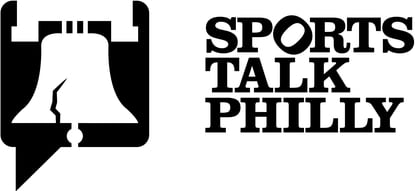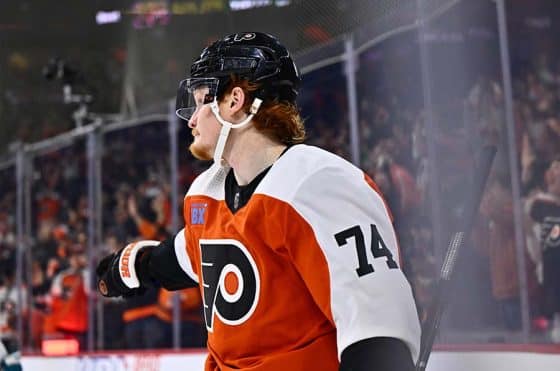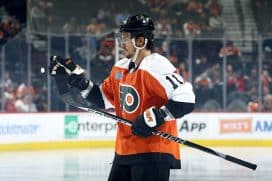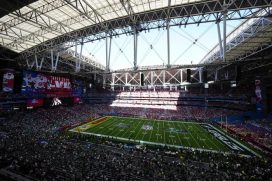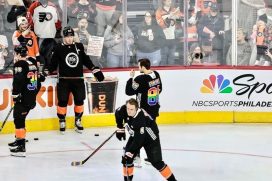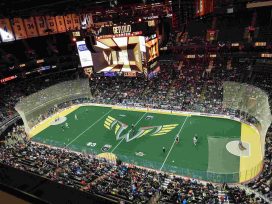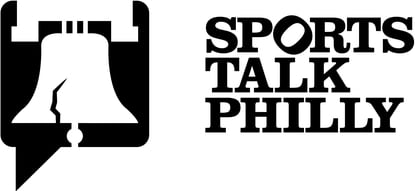Entering the 2015 NHL Draft, the Philadelphia Flyers have a dearth of goaltending prospects in the system. The only two prospect-aged goaltenders to whom the Flyers hold NHL rights are 21-year-old Anthony Stolarz and Harvard University goaltender Merrick Madsen.
Stolarz, the Flyers' second round pick in 2012, is coming off an up-and-down rookie pro season with the American Hockey League's Lehigh Valley Phantoms. Madsen, a sixth-round pick in 2013, appeared in only one game as a Harvard freshman in 2014-15.
The organization is still high on Stolarz's long-range NHL potential but concedes that it will likely be a lengthy process of development before he is NHL ready. Madsen needs playing time to establish himself at the collegiate level before he could even be considered a pro-hockey prospect.
Flyers scouting director Chris Pryor says that the organization is well aware of the need for more goaltending prospect depth in the system.
A year ago, the Flyers were in the same situation but were unable to select any goaltenders with their six picks. That happened because, starting in the second round, there were runs on goalie selections in the rounds where Flyers had desired goaltenders pegged.
Pryor said the organization would not "reach" for a much lower-ranked prospect simply for the sake of taking a goaltender. As a result, the Flyers ended up selecting three defensemen (first-round pick Travis Sanheim, third-rounder Mark Friedman and seventh-rounder Jesper Pettersson) as well as three forwards (second-round choice Nicolas Aube-Kubel, fifth-round pick Oskar Lindblom and sixth-rounder Radel Fazleev) and no goaltenders.
Thus far, the organization's crop of 2014 draftees has shown varying degrees of pro-level potential across the board. Not surprisingly, Pryor said the organization will stand by the same approach this year of only taking a goaltender if there is a sufficiently high-ranked goalie available in the range where the Flyers are comfortable selecting him.
Nevertheless, the Flyers are optimistic of being able to select a desired goaltending prospect or two in what is considered a deep overall draft. After a series of moves by general manager Ron Hextall, the Flyers hold four picks in the top 70 and seven in the top 99. They will pick twice in the first round and own at least one selection in every round.
"It's something that Ron's spent a lot of time with, accumulating assets, and it's a good year to have a lot of picks because the draft's as deep as it is," Pryor said. "We're excited. Hopefully it'll enable us to fill some areas that we need to get a little bit more of, and there's some quality guys out there that we're hoping are still available when we pick."
Specific to goaltenders, Pryor said, "We’ve got guys targeted in different areas that we might have a chance to talk about. We’re talking about different spots in the draft. We’re going to try to address that if we can."
Might the Flyers even use the 29th overall pick of the Draft, acquired in the Braydon Coburn trade with the Tampa Bay Lightning, on a goaltender if the first 28 picks are position players? On a league-wide basis, no NHL team has selected a goaltender in the first round since 2012 (Andrei Vasilevskiy by Tampa at 19th overall and Malcolm Subban by Boston at 24th overall). In fact, there have only been four goalies taken in the first round dating back to 2009.
Herein lies the conundrum of goaltender drafting: It takes a long time to develop goaltenders and there are absolutely no guarantees that one drafted in the first round will end up being a superior NHL goalie to one selected later on or even one who goes undrafted and is signed later on as a free agent.
Among all goalies drafted in any round of the NHL Draft from 2008 onward, only Braden Holtby (selected by Washington in the fourth round, 93rd overall, in 2008) has reached the 150-game mark in the NHL up to this point in his career. In the meantime, there have been multiple undrafted goalies who debuted in the NHL within that time period who have surpassed that mark. The ranks of the latter category include Columbus Blue Jackets goaltender Sergei Bobrovsky, a former Vezina Trophy winner who was originally signed by the Flyers as a rookie free agent in 2010. Another is former Stanley Cup winning goaltender Antti Niemi.
Will there be a goalie in the Class of 2015 who could sneak into the first round of the Draft? Russian netminder Ilya Samsonov, Canadian netminder Mackenzie Blackwood and Swedish goalie Felix Sandström are all well-regarded prospects. TSN's Craig Button has Samsonov ranked 14th overall on his final "Craig's List."
Pryor said he thinks there is a possibility that a team in the bottom one-third of the first round could opt for a goaltender. However, based on his comments, it seems that Pryor himself does not believe there is a clear-cut top goaltending prospect at this point. By extension, the odds seem fairly low that the Flyers will have a goalie ranked as the best available player when they make their second pick of the first round.
Said Pryor, "I think it could be [possible that a goalie goes in the first round]. I think there’s a number of goalies… I don’t know if right now if there’s any one particular goalie who’s making a statement to say I’m the guy, but when I say that, there’s a group of guys that any one of those guys could be the first guy taken. I think there’s always a chance. I think if it does happen, I think it’s going to be somewhere in the 20th pick on back. There’s a group of goalies that we like, and when you put it with that group of players, we’ll see how it translates, but it wouldn’t surprise me if one of those goalies had someone yell their name off on Friday."
The late, great comedian Mitch Hedberg used to tell a joke about how long it takes to cook a baked potato in a conventional oven. "Sometimes, I'll just throw one in there, even if I don't want it," he said. "By the time it's done, who knows?"
Drafting and developing goaltenders is much the same. It takes so long for most draft-eligible goaltenders to be ready for the NHL that, by the time they are finished "cooking", there's no telling what a team might actually have in that player. Most NHL scouts will tell you that they consider the projection of teenage goalies to involve the most guesswork of any pre-Draft preparation they do.
For this reason, NHL teams have collectively become leery of using first-round picks on goaltenders. There are exceptions, of course, but the risk of subsequent buyers' remorse is just too high in most cases to justify going with a goalie over a position player in Round One.
On the other hand, it is not a bad strategy to take a goalie at some point in most every Draft if possible. An NHL team may be set in goal for right now. By the time the drafted goal is done done developing, who knows?
The 2008 Draft is a good example.
Heading into the Draft, Tri-City Americans goaltender Chet Pickard was far and away considered the best available goalie in the Draft, with some saying he had franchise player potential. It was widely reported on Draft day that the Flyers tried to move up in order to select Pickard. They were unable to do so, and the Nashville Predators chose Pickard with the 18th overall pick of the first round. Philadelphia, selecting 19th, chose defenseman Luca Sbisa.
As it turned out, Pickard was a major bust. He struggled in AHL, was demoted to the ECHL, and did not fare too well even at that level. Nashville's seventh-round selection (207th overall) in the same Draft, Anders Lindbäck, has at least gone on to become an NHL player. Up to this point, Washington Capitals fourth-round pick, Braden Holtby, has arguably been the top NHL goalie to come out of the 2008 Draft.
There is no such thing as too much organizational depth at a particular position, including goaltenders. Goalie prospects too often fall by the wayside. No matter what a goalie does in collegiate or Canadian junior hockey, the World Junior Championships or even the top European pro leagues or AHL, it's a whole different ballgame once they he gets to the NHL.
The Flyers know this first-hand.
From 1995 to 1999, the organization used its top overall Draft pick — two first-rounders and an early second-rounder — three times. By 1999, goaltending prospect depth was considered the biggest strength of the Philadelphia farm system. In the summer of 1999, there were no fewer than five goalies in the Flyers system who were considered to be potential future NHL starters. There was also one fringe prospect. This does not even include Johan Hedberg (drafted in the 9th round of the 1994 Draft), whose rights had been traded to San Jose after his agent and Bob Clarke were unable to agree on a contract.
Let's revisit the NHL prospect goaltenders the Flyers had in their system in the summer of 1999. Five of them played in the NHL (three only briefly). Two had stints as starters. None became long-term impact players in the NHL. Welcome to the vicissitudes of goalie drafting and development.
In 1995, the Flyers used their first-round pick (22nd overall) to select Brian Boucher. According to The Hockey News' Draft Preview that year, most scouts considered him the fourth-best goalie prospect in a goalie-rich draft, behind Martin Biron, J-S Giguere and Marc Denis but a first-round worthy prospect in his own right. As of 1999, he looked to be on track to graduate to the NHL in the near future.
In the 1996 draft, Philly took Swedish goaltender Per-Ragnar Bergkvist, in the 5th round (124th overall), largely because Bergkvist had outplayed Boucher head-to-head at the most recent World Junior Championships. Unfortunately, Bergkvist proved to be a flash in the pan and never became even an average Elitserien goalie. In 1999, however, he had a brief revival with Färjestad and was at least considered a fringe prospect.
In the 1997 draft, the Flyers used their first pick of the draft (30th overall) to select Jean-Marc Pelletier. The second-round draftee made a quick splash with the Phantoms in 1998-99 and even earned a start with the big club — which didn't go very well — while the club was struggling and looking for a spark. Although his stock soon fell, Pelletier still looked like a solid NHL prospect in the summer of 1999.
In the 1998 draft, the Flyers took Antero Niitymäki in the 6th round (168th overall). A product of the vaunted TPS Turku system, which produced a string of future NHL goalies, Niittymäki got an extended chance to play with the TPS team in SM-Liiga when Fredrik Norrena went down with an injury. Niitty ended up winning the 1999-2000 Rookie of the Year award in SM-Liiga and TPS won the championship.
In the 1999 draft, the Flyers selected Maxime Ouellet in the first round after Boston snapped up defenseman Nick Boyton (a draft re-entry after he was selected 9th overall by Washington in 1997 but did not sign a contract) one pick earlier. Considered by many to be the best goalie available in the draft, many scouts thought he had future NHL All-Star potential. Ouellet would go to play for Team Canada at the WJC and actually started the 2000-01 season on the Flyers' NHL roster before being returned to the QMJHL.
Of course we know what happened to this deep pool of prospects; chock full of potential "goalie-of-the-future" candidates. One by one, they fell by the wayside.
Boucher had an amazing NHL rookie season and led the Flyers to the Eastern Conference Finals in 1999-2000. He faltered in his second season and lost his job to Roman Cechmanek (drafted by the Flyers at age 29 in the 6th round of the 2000 NHL draft after he won five straight Czech championships with HC Vsetin). Boosh never blossomed into a star but ended up becoming a solid journeyman goalie who spent four stints — three that included time in the NHL — with the Flyers' organization.
After flopping with Leksand and playing a year in Norway, Bergkvist's brief revival with FBK didn't last beyond the first month of the 1999-2000 season. He ended up playing his way down to third-string goalie and faded away from the hockey scene.
Pelletier's cockiness was considered a plus when he stepped up in the first half of his rookie pro season with the Phantoms, but soon started to work against him as he leveled off and gained the reputation for being uncoachable. He ended up being traded to Carolina in the deal that brought Keith Primeau to Philadelphia and sent Rod Brind'Amour to the Hurricanes. Pelletier turned into pretty much a career minor-league goaltender.
Niittymäki ended up being arguably the best of the bunch, if you exclude Czech veteran Cechmanek (who was already a finished product by the time he was drafted). Niitty won three straight Finnish championships, a Calder Cup, an AHL playoff MVP award, an Olympic silver medal and Olympic MVP award. But he had only spotty success in the NHL. Like Boucher, he was unable to keep a full-time starting job in the NHL, and he did not prove to be the answer to the Flyers' search for a long-term answer in goal. Repeated hip injuries — which eventually resulted in hip replacement surgery and hastened the premature end to his career — undoubtedly set back his development once he reached the NHL.
Ouellet's flaws started to become apparent soon after he graduated from junior to professional hockey. He was still highly regarded at the time the Flyers sent him to Washington in the ill-fated Adam Oates rental. However, his game never progressed and, like Pelletier, he ended up becoming more or less a career minor league goaltender.
Cechmanek was beyond traditional prospect age by the time he entered the Flyers' organization, so I will not discuss him at length here.
The purpose for looking back at all of those Flyers draftees from that mid- to late-1990s time frame is to show that, of all positions on the ice, goalies are truly the hardest to predict once they turn pro. Even when they reach the top level, there are many goalies who are late bloomers.
Bill Meltzer is a columnist for Flyerdelphia. Follow him on Twitter @billmeltzer.
